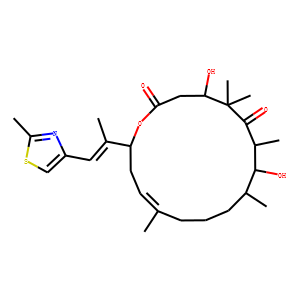| InChI | InChI=1S/C27H41NO5S/c1-16-9-8-10-17(2)25(31)19(4)26(32)27(6,7)23(29)14-24(30)33-22(12-11-16)18(3)13-21-15-34-20(5)28-21/h11,13,15,17,19,22-23,25,29,31H,8-10,12,14H2,1-7H3/b16-11-,18-13+/t17-,19+,22-,23-,25-/m0/s1 |
| Reference | 1. Cancer Chemother Pharmacol. 2005 Sep;56(3):255-60. Epub 2005 May 3. <br />
Preclinical pharmacology of epothilone D, a novel tubulin-stabilizing antitumor
agent. <br />
Wang H(1), Wang Z, Wang S, Li M, Nan L, Rhie JK, Covey JM, Zhang R, Hill DL. <br />
Author information: <br />
(1)Department of Pharmacology and Toxicology, Division of Clinical Pharmacology,
Cancer Pharmacology Laboratory, Comprehensive Cancer Center, University of
Alabama at Birmingham, Birmingham, AL 35294, USA. [email protected] <br />
PURPOSE: To determine, for various species, the pharmacological and biochemical
properties of epothilone D (EpoD) that are relevant in establishing an
appropriate animal model for further evaluation of this promising antitumor
agent.<br />
METHODS: A method involving high-performance liquid chromatography (HPLC) was
developed and used to assess the stability and protein binding of EpoD in plasma
from various species, its metabolism by various S9 fractions, and its
pharmacokinetics in mice.<br />
RESULTS: EpoD was stable in dog and human plasma. In plasma from other species,
stability decreased in the order: hamster > mouse > guinea pig > rat. EpoD was
highly bound to proteins in dog and human plasma. In an evaluation of S9
fractions from mouse, rat, guinea pig, dog, and human, mouse S9 was most
efficient in metabolizing EpoD. Following administration to CD2F1 mice, the
initial half-lives for plasma elimination of EpoD were <5 min for an intravenous
dose and <20 min for an intraperitoneal dose.<br />
CONCLUSIONS: The species differences in EpoD biostability and metabolism may have
implications in assessing its antitumor activity and pharmacologic and
toxicologic profiles in humans. Relative to humans, the mouse is not a good model
for disposition of EpoD; the dog would be more appropriate. <br />
2. Biotechnol Bioeng. 2002 May 5;78(3):280-8. <br />
Optimizing the heterologous production of epothilone D in Myxococcus xanthus. <br />
Lau J(1), Frykman S, Regentin R, Ou S, Tsuruta H, Licari P. <br />
Author information: <br />
(1)Department of Process Science, Kosan Biosciences, Inc., 3832 Bay Center Place,
Hayward, CA 94545, USA. [email protected] <br />
The heterologous production of epothilone D in Myxococcus xanthus was improved by
140-fold from an initial titer of 0.16 mg/L with the incorporation of an adsorber
resin, the identification of a suitable carbon source, and the implementation of
a fed-batch process. To reduce the degradation of epothilone D in the basal
medium, XAD-16 (20 g/L) was added to stabilize the secreted product. This greatly
facilitated its recovery and enhanced the yield by three-fold. The potential of
using oils as a carbon source for cell growth and product formation was also
evaluated. From a screen of various oils, methyl oleate was shown to have the
greatest impact. At the optimal concentration of 7 mL/L in a batch process, the
maximum cell density was increased from 0.4 g dry cell weight (DCW)/L to 2 g
DCW/L. Product yield, however, depended on the presence of trace elements in the
production medium. With an exogenous supplement of trace metals to the basal
medium, the peak epothilone D titer was enhanced eight-fold. This finding
demonstrates the significant role of metal ions in cell metabolism and in
epothilone biosynthesis. To further increase the product yield, a continuous
fed-batch process was used to promote a higher cell density and to maintain an
extended production period. The optimized fed-batch cultures consistently yielded
a cell density of 7 g DCW/L and an average production titer of 23 mg/L. <br />
3. J Nat Prod. 2002 Apr;65(4):570-2. <br />
Large-scale isolation and crystallization of epothilone D from Myxococcus xanthus
cultures. <br />
Arslanian RL(1), Parker CD, Wang PK, McIntire JR, Lau J, Starks C, Licari PJ. <br />
Author information: <br />
(1)Kosan Biosciences, Inc., 3832 Bay Center Place, Hayward, California 94545,
USA. [email protected] <br />
The introduction of the epothilone polyketide synthase (PKS) into Myxococcus
xanthus has enabled the heterologous production of epothilone D (1) on a large
scale. To isolate this valuable product from the fermentation medium, an
economical, scalable, and high-yielding purification process was developed. With
the crystallization of 1 from a binary solvent system that consisted of ethanol
and water, the product was recovered as white crystals with a final purity of >
or =97% (w/w). This is the first reported crystallization of 1. <br />
|

